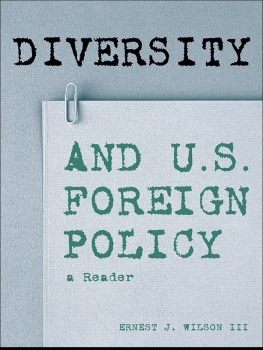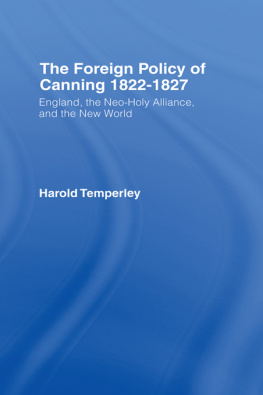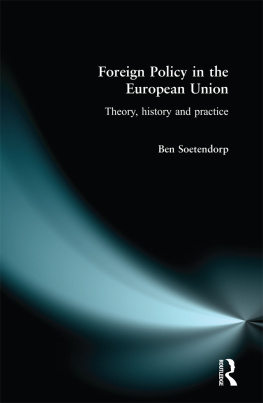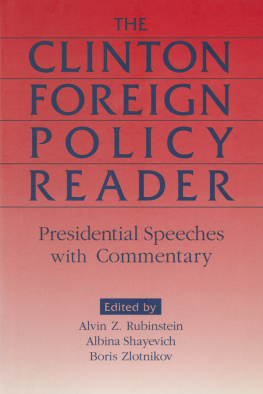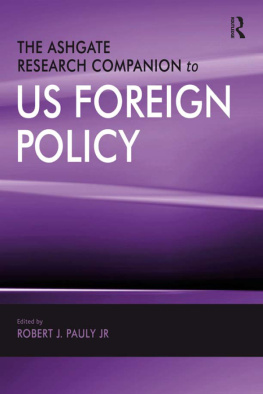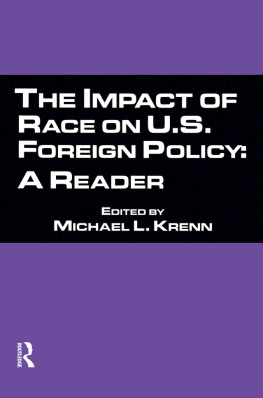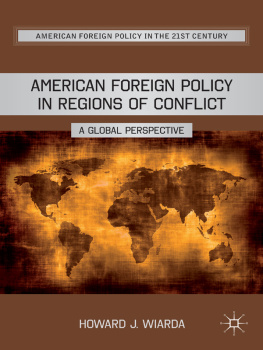DIVERSITY AND U.S. FOREIGN POLICY
DIVERSITY AND U.S. FOREIGN POLICY
a Reader
ERNEST J. WILSON III
ROUTLEDGE New York London
Published in 2004 by
Routledge
270 Madison Avenue
New York, NY 10016
www.routledge-ny.com
Published in Great Britain by
Routledge
2 Park Square
Milton Park, Abingdon
Oxon OX14 4RN U.K.
www.routledge.co.uk
Routledge is an imprint of the Taylor & Francis Group.
2004 by Taylor & Francis Books, Inc.
Roautledge is an imprint of the Taylor and Francis Group.
This edition published in the Taylor & Francis e-Library, 2005.
To purchase your own copy of this or any of Taylor & Francis or Routledges collection of thousands of eBooks please go to www.eBookstore.tandf.co.uk.
All rights reserved. No part of this book may be printed or utilized in any form or by any electronic, mechanical or other means, now known or hereafter invented, including photocopying and recording, or any other information storage or retrieval system, without permission in writing from the publisher.
Library of Congress Cataloging-in-Publication Data
Diversity and U.S. foreign policy : a reader /edited by Ernest J. Wilson, III.
p. cm.
Includes bibliographic references (p. ) and index.
ISBN 0-415-92857-5 (hc : alk. paper) ISBN 0-415-92884-2 (pb : alk. paper)
1. United StatesForeign relations1989 2. MulticulturalismUnited States. 3. Pluralism (Social sciences)United States. I. Wilson, Ernest J., III
E895.D59 2004
327.73'0089dc22
2003023609
ISBN 0-203-48704-4 Master e-book ISBN
ISBN 0-203-57512-1 (Adobe eReader Format)
Acknowledgments
The ideas about multiculturalism and international affairs explored in this volume were inspired by more than twenty-five years working in a variety of national and international institutions and universities. As a professor, I teach and write on these issues regularly. As a practitioner, I have observed ethnic and racial dynamics at close hand while serving as a senior staff member of the National Security Council at the White House, as a Congressional aid, in nonprofits such as the Council on Foreign Relations, and in private bodies such as the Global Information Infrastructure Commission.
This volume owes a great deal to individuals and institutions who provided unique opportunities to develop my ideas in supportive and challenging environments. Tom Rowe at the University of Denver and his International Career Advancement Program hosts each year a weeklong seminar in Aspen, Colorado, where these ideas are taken seriously and discussed by international affairs professionals. His vision and commitment helped inspire this volume. Abe Lowenthal, the founder of the Pacific Council on International Policy, held a national conference of Latinos, Asian Americans, and African Americans that prompted some of the work in this collection, and he has been a welcome part of the conversation since then. The Council on Foreign Relations wrestles regularly with these issues, and Council President Les Gelb has supported several initiatives at that body in which I have participated. The minority fellowship programs for college juniors interested in international affairs, under their various names, let me interact with some of the best and brightest young people in our country at the policy schools of the universities of Michigan and Maryland. The late William Diaz was an early leader and supporter of these programs at the Ford Foundation. For its part, the Congressional Black Caucus consistently takes on these tough issues at its annual forum, and there I have been privileged to work with Congressmen Sanford Bishop, Charles Diggs, Bill Gray, Mickey Leland, and Don Payne.
Others who informed the shape of this project include Goler Butcher, George Dalley, Rudolpho de la Garza, I. M. Destler, Lauri Fitz-Pegado, Will Itoh, Ed Perkins, Susan Rice, Peter Romero, Elliott Skinner, Shibley Telhami, and the members of the long-standing foreign affairs Sunday brunch.
Of all these experiences, working as a senior advisor on President Clintons 1992 national security and foreign affairs transition team helping select Cabinet and sub-Cabinet appointees was the best lesson imaginable to learn how the mix of technical expertise, substantive experience, political commitments, campaign support, gender, and ethnicity intersect at the highest levels of the foreign policy community. To that team, I extend my heartfelt thanks.
Research assistance is gratefully acknowledged from Bidisha Biswas, Tanja Owe, NehaSahgal, and Delgreco Wilson. Finally, the following people read portions of this manuscript and made useful suggestions: Eric Henderson, Eric Liu, Miroslav Nincic, and BoranyPenh. These colleagues and friends made this volume better than it would otherwise be; any errors of fact or judgment are my own.
Preface
This book is designed for readers interested in the multiple intersections of multiculturalism and foreign affairs. It can be read with value by students of international relations who wish to understand how the design and conduct of U.S. foreign policy is being shaped by ethnicity. It also can benefit those whose main interest is multiculturalism, and who wish to see how these forces play themselves out in the international arena.
The selection of materials for this volume reflects the editors belief that the dividing line between the foreign and domestic has thinned over recent decades, and what was once foreign has become much more domestic, and vice versa. It also reflects the reality that the United States is now experiencing one of the greatest influx of immigrants in its history, paralleling the great waves of new Americans that came to our shores at the turn of the last century. These newer immigrants, however, come from different countries with different cultures, and of course the global context of these two massive shifts is very different. The intersection of these elementsglobalization, multiculturalism, and foreign affairsis the subject of this volume.
The opening essay in this book, Framing the Discussion of Diversity, Globalization, and U.S. International Affairs, grapples with the leading themes that emerge from this edited volume, and defines the meaning of the key termsglobalization, multiculturalism, and foreign affairs. It identifies the drivers of change that propel these phenomena toward their multiple intersections. The essay then analyzes several unique aspects of minority groups' views of foreign affairssuggesting that these elements may create stronger U.S. international relations with the world. The essay also points to the current debate over the implications of domestic diversity and the conduct of U.S. international affairs.
I call the framework that unites these elements Double Diversity, and the readings were selected to reflect this framework. The final reading analyzes this concept. Double Diversity begins with the notion that a great challenge and opportunity for America is integrating growing domestic diversity with increasing international diversity. In both, the position of people of color has become critically important. Internationally, few meetings of the World Trade Organization (WTO), the World Bank, or the United Nations occur without representation of countries once absent from these deliberations, for example, China, India, and Brazil. These three alone today represent more than a third of the worlds population. By some accounts, China is the second largest economy in the world after the United States, and Brazil is easily the eighth largest. At home, America is becoming more brown, yellow, and black, as more people come to the United States from Africa, Asia, and Latin America. The way these two forces, external and internal, will interact cannot be predicted, and their combination suggests significant risks and opportunities that may hurt or help America. The terrorist attacks of 2001 force us to reflect on these issues, and they elevate multiculturalism to an issue of national security.

